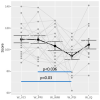Visual Function and Neuropsychological Profiling of Idiopathic Infantile Nystagmus
- PMID: 37759948
- PMCID: PMC10526276
- DOI: 10.3390/brainsci13091348
Visual Function and Neuropsychological Profiling of Idiopathic Infantile Nystagmus
Abstract
Though considered a benign condition, idiopathic infantile nystagmus (IIN) may be associated with decreased visual acuity and oculo-motor abnormalities, resulting in developmental delays and poor academic performance. Nevertheless, the specific visual function profile of IIN and its possible impact on neuropsychological development have been poorly investigated. To fill this gap, we retrospectively collected the clinical data of 60 children presenting with IIN over a 10-year period (43 male; mean age of 7 years, range of 2 months-17 years, 9 months). The majority of the subjects in our cohort presented with reduced visual acuity for far distances and normal visual acuity for near distances, associated with oculo-motor abnormalities. The overall scores of cognitive and visual-cognitive tests were in the normal range, but revealed peculiar cognitive and visual-cognitive profiles, defined by specific frailties in processing speed and visual-motor integration. The same neuropsychological profiles characterize many neurodevelopmental disorders and may express a transnosographic vulnerability of the dorsal stream. As the first study to explore the neuropsychologic competencies in children with IIN, our study unveils the presence of subclinical frailties that need to be addressed to sustain academic and social inclusion.
Keywords: Beery-VMI; WISC-IV; dorsal stream vulnerability; idiopathic infantile nystagmus; neurodevelopment; vision; visual impairment; visual–motor integration.
Conflict of interest statement
The authors declare that the research was conducted in the absence of any commercial or financial relationships that could be construed as a potential conflict of interest.
Figures




References
LinkOut - more resources
Full Text Sources
Research Materials
Miscellaneous

